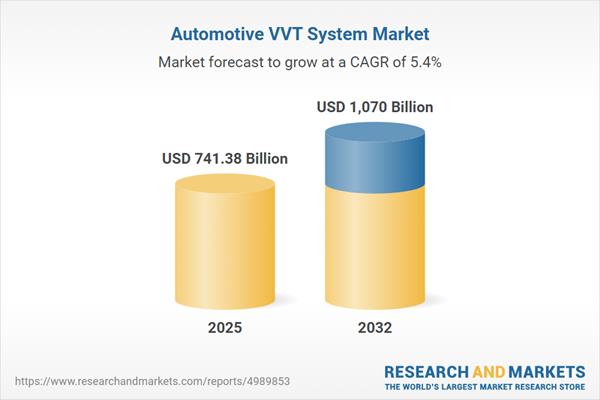Speak directly to the analyst to clarify any post sales queries you may have.
Variable valve timing (VVT) systems are reshaping the automotive industry by enabling advanced powertrain solutions that drive performance, efficiency, and regulatory compliance. As sustainability and operational optimization define industry priorities, the automotive VVT system market is becoming a focal point for senior decision-makers seeking strategic growth opportunities.
Market Snapshot: Automotive VVT System Market Growth and Outlook
The automotive VVT system market saw revenue growth from USD 705.47 billion in 2024 to USD 741.38 billion in 2025. It is set to maintain momentum, expanding at a projected CAGR of 5.37% to reach USD 1.07 trillion by 2032. This trajectory reflects increased adoption across vehicle segments and heightened investment in advanced valvetrain technology.
Scope & Segmentation of the Automotive VVT System Market
This report delivers comprehensive segmentation, allowing automotive leaders to tailor their strategies. Key areas include:
- Component: Camshaft, Electronic Control Unit (ECU), Timing Chain/Belt, VVT Actuator
- Technology: Variable Valve Timing – intelligent, intelligent by electric motor, intelligent wide
- Valve Train: Dual Overhead Camshaft, Single Overhead Camshaft
- Vehicle Type: Commercial Vehicles, Electric and Hybrid Vehicles, Passenger Vehicles
- Fuel Type: Diesel Engines, Gasoline Engines
- End User: Aftermarket, Original Equipment Manufacturers
- Regional Coverage: Americas (United States, Canada, Mexico, Brazil, Argentina, Chile, Colombia, Peru), Europe, Middle East & Africa (United Kingdom, Germany, France, Russia, Italy, Spain, Netherlands, Sweden, Poland, Switzerland, UAE, Saudi Arabia, Qatar, Turkey, Israel, South Africa, Nigeria, Egypt, Kenya), Asia-Pacific (China, India, Japan, Australia, South Korea, Indonesia, Thailand, Malaysia, Singapore, Taiwan)
- Company Profiles: Aisin Seiki Co., Ltd., BorgWarner Inc., Camcraft, Inc., Compagnie de Saint-Gobain S.A., Delphi Technologies, Eaton Corporation PLC, Ford Motor Company, Grimmer Motors Ltd., Hitachi Automotive Systems Ltd., Honda Motor Co., Ltd., Husco International, Inc., Hyundai Motor Company, Maruti Suzuki India Limited, Mikuni Corporation, Sensata Technologies, Inc., Toyota Motor Corporation
Key Takeaways for Senior Decision-Makers
- Variable valve timing systems are advancing engine responsiveness and fuel efficiency, supporting both emissions reduction and evolving customer expectations.
- Recent progress in electric and hydraulic actuation, combined with sophisticated sensor technology, is reshaping powertrain calibration and adaptation across diverse vehicle types and fuel systems.
- The expansion of VVT solutions in hybrid and electrified vehicles presents new opportunities for integration with battery management and range-extender designs.
- Segment-specific demands, such as durability for commercial vehicles and performance for passenger cars, drive the need for flexible component sourcing and system design.
- OEMs and tiered suppliers are leveraging partnerships, advanced manufacturing, and local content strategies to build resilience against supply disruptions and adapt to evolving trade policies.
Impact of 2025 United States Tariff Adjustments
Tariff changes in the United States have prompted a reevaluation of sourcing strategies for key VVT system components. Manufacturers are adapting by strengthening partnerships with regional foundries and electronics firms, increasing investment in nearshoring and automation, and building cost models that reflect new duty structures. These actions minimize tariff exposures while increasing agility in response to regulatory or market shifts.
Methodology & Data Sources
The findings are based on a hybrid research approach. Secondary research synthesized technical publications, regulatory filings, market commentary, and supplier disclosures. Primary research included executive interviews and expert workshops, supplemented by quantitative trade data analysis and facility visits. This robust process ensures high-quality, actionable intelligence for decision-makers.
Why This Report Matters
- Enables evidence-based investment in advanced VVT technologies and future-proof component portfolios.
- Supports risk management by clarifying tariff, sourcing, and regulatory impacts on powertrain supply chains.
- Empowers leadership teams to align product roadmaps with region- and segment-specific opportunities for growth and resilience.
Conclusion
For senior automotive executives, the VVT system market provides a strategic lens for meeting future engine performance, sustainability, and supply chain objectives. By leveraging this granular analysis, organizations can confidently navigate transformation and secure a competitive edge in core and emerging markets.
Additional Product Information:
- Purchase of this report includes 1 year online access with quarterly updates.
- This report can be updated on request. Please contact our Customer Experience team using the Ask a Question widget on our website.
Table of Contents
3. Executive Summary
4. Market Overview
7. Cumulative Impact of Artificial Intelligence 2025
Companies Mentioned
The companies profiled in this Automotive VVT System market report include:- Aisin Seiki Co., Ltd.
- BorgWarner Inc.
- Camcraft, Inc.
- Compagnie de Saint-Gobain S.A.
- Delphi Technologies
- Eaton Corporation PLC
- Ford Motor Company
- Grimmer Motors Ltd.
- Hitachi Automotive Systems Ltd.
- Honda Motor Co., Ltd.
- Husco International, Inc.
- Hyundai Motor Company
- Maruti Suzuki India Limited
- Mikuni Corporation
- Sensata Technologies, Inc.
- Toyota Motor Corporation
Table Information
| Report Attribute | Details |
|---|---|
| No. of Pages | 198 |
| Published | November 2025 |
| Forecast Period | 2025 - 2032 |
| Estimated Market Value ( USD | $ 741.38 Billion |
| Forecasted Market Value ( USD | $ 1070 Billion |
| Compound Annual Growth Rate | 5.3% |
| Regions Covered | Global |
| No. of Companies Mentioned | 17 |









